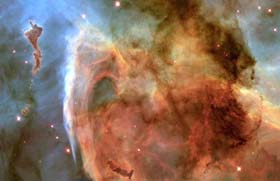Carina Nebula (NGC 3372)

The Carina Nebula (NGC 3372) <br>Credits: NASA, The Hubble Heritage Team (AURA/STScI)
Previously unseen details of a mysterious, complex structure within the Carina Nebula (NGC 3372), also called the ’Keyhole Nebula’, are revealed by this image obtained with the NASA/ESA Hubble Space Telescope.
The picture is a montage assembled from four different April 1999 telescope pointings with Hubble’s Wide Field Planetary Camera 2, which used six different colour filters.
The picture is dominated by a large, approximately circular feature, about 7 light-years across, which is part of the Keyhole Nebula, named in the 19th century by British astronomer Sir John Herschel. This region, about 8000 light-years from Earth, is located near to the famous explosive variable star Eta Carinae, which lies just outside the field of view toward the upper right.
The Carina Nebula also contains several other stars that are among the hottest and most massive known, each about 10 times as hot, and 100 times as massive, as our Sun.
The circular ’keyhole’ structure contains both bright filaments of hot gas and dark silhouetted clouds of cold molecules and dust, all of which are in rapid, chaotic motion. Two striking large, sharp-edged dust clouds are located near the bottom centre and upper-left edges of the image. These large dark clouds may eventually evaporate or, if there are sufficiently dense condensations within them, give birth to small star clusters.
The Carina Nebula, with an overall diameter of more than 200 light-years, is one of the outstanding features of the southern-hemisphere part of the Milky Way.
Media Contact
More Information:
http://www.esa.int/export/esaSC/SEMAJS374OD_sensations_0.htmlAll latest news from the category: Physics and Astronomy
This area deals with the fundamental laws and building blocks of nature and how they interact, the properties and the behavior of matter, and research into space and time and their structures.
innovations-report provides in-depth reports and articles on subjects such as astrophysics, laser technologies, nuclear, quantum, particle and solid-state physics, nanotechnologies, planetary research and findings (Mars, Venus) and developments related to the Hubble Telescope.
Newest articles

A universal framework for spatial biology
SpatialData is a freely accessible tool to unify and integrate data from different omics technologies accounting for spatial information, which can provide holistic insights into health and disease. Biological processes…

How complex biological processes arise
A $20 million grant from the U.S. National Science Foundation (NSF) will support the establishment and operation of the National Synthesis Center for Emergence in the Molecular and Cellular Sciences (NCEMS) at…

Airborne single-photon lidar system achieves high-resolution 3D imaging
Compact, low-power system opens doors for photon-efficient drone and satellite-based environmental monitoring and mapping. Researchers have developed a compact and lightweight single-photon airborne lidar system that can acquire high-resolution 3D…





















